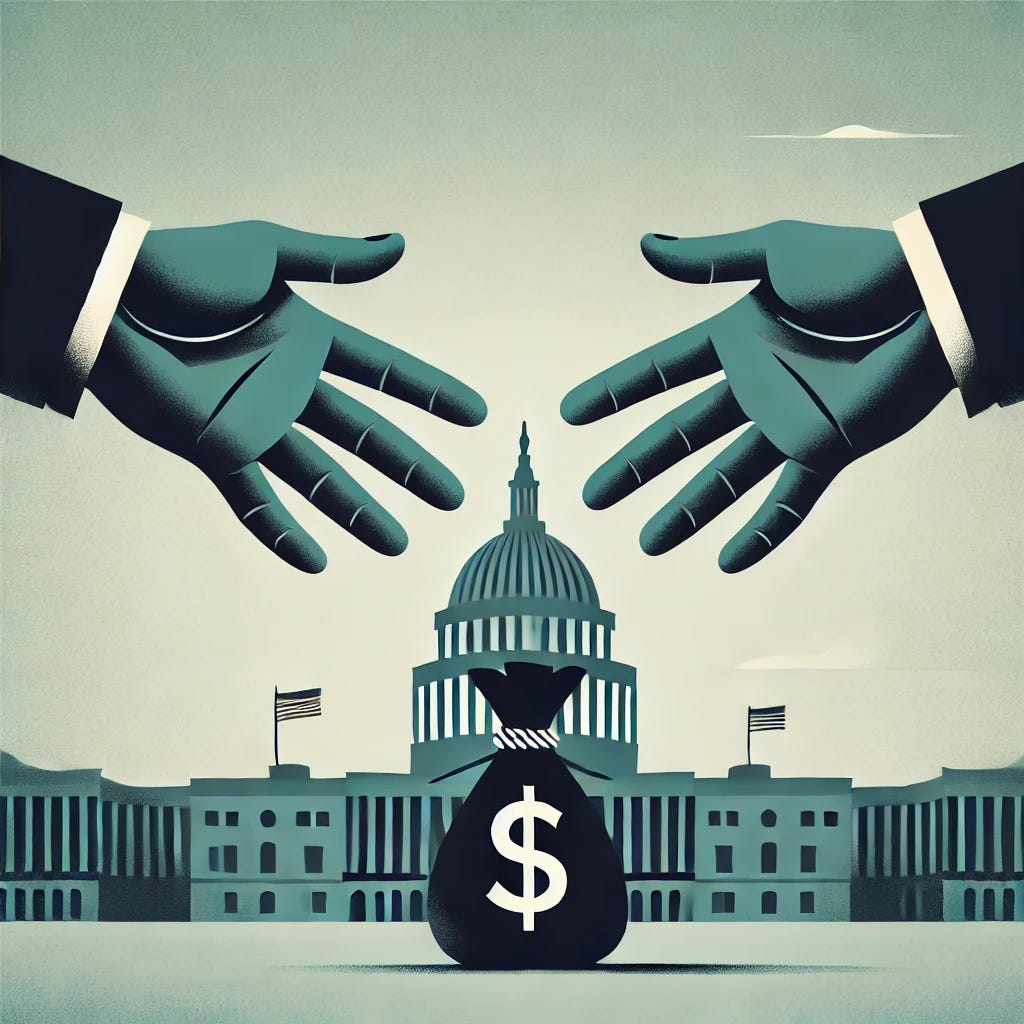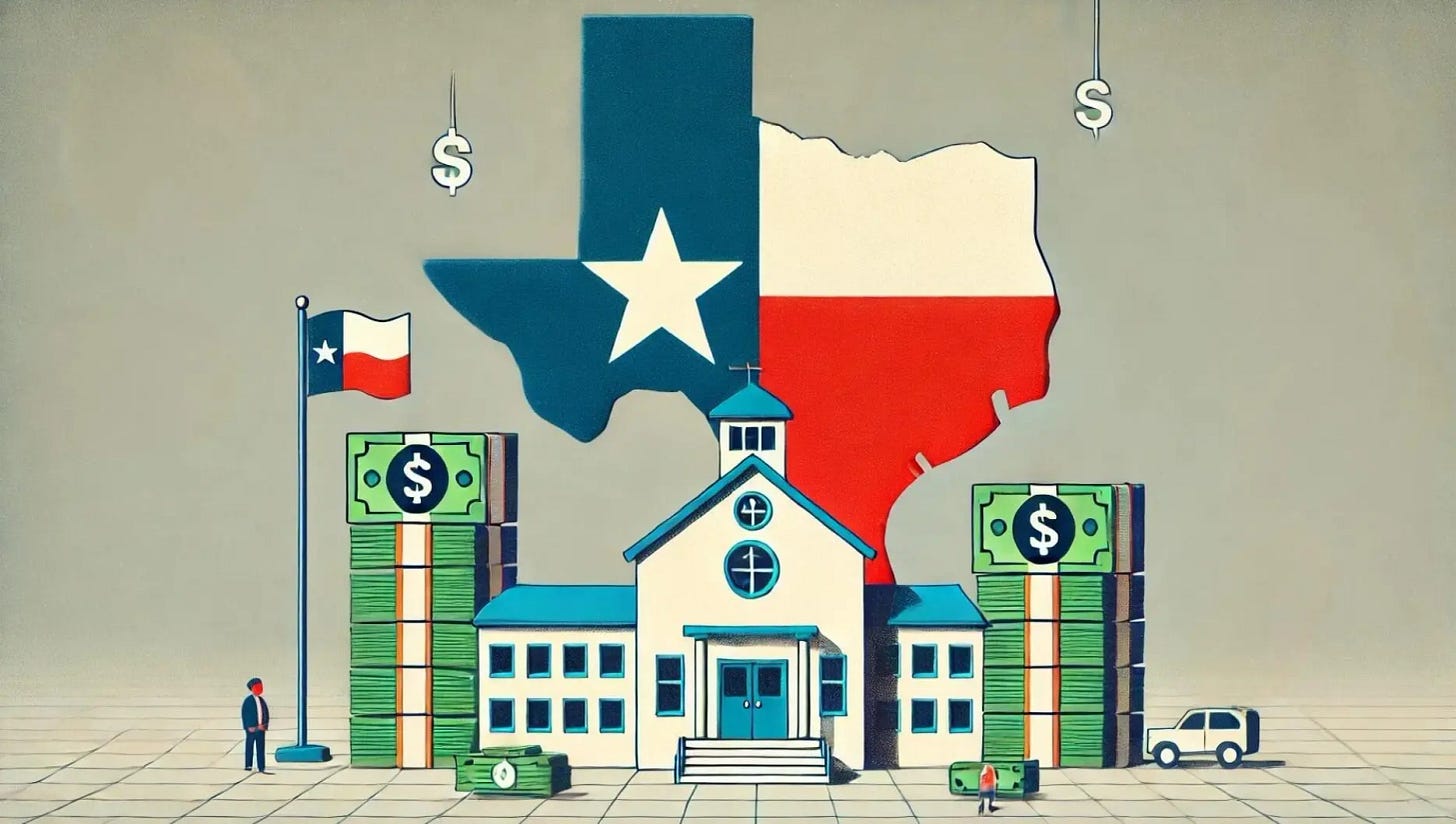291. Why Government Handouts Don't Support Prosperity | This Week's Economy Ep. 79
Big government is the problem.
Hello Friends!
Welcome back! In episode 79 of This Week's Economy, I discuss the need for improvements in patient care, property tax burdens, taxpayer giveaways, protectionism, federal spending, and overfunding public education. Watch the episode on YouTube below, listen to it on Apple Podcast or Spotify, and visit my website for more information.
1. Improve Patient Care, Not the System
In the News: There has not been much conversation on health policy during this election; however, J.D. Vance said in a recent interview that Trump’s plan would mainly be to de-regulate the insurance market. Meanwhile, a new report predicts U.S. employers will see health insurance costs rise an average of 5.8% in 2025. This is the third consecutive year in which healthcare costs for employers have risen more than 5%. Sources: The Hill, Reuters
My Take:
The Problem: Employer-sponsored health insurance costs have risen 50% since 2017 due to inflation, rising drug costs, chronic illness treatment, and regulations. This system limits competition and inflates prices.
Current System: 65 million Americans rely on employer-sponsored insurance. However, it restricts choices and controls $1.2 trillion in healthcare spending that employees could use directly or put into HSAs for workers to control.
Solution: Congress should give tax benefits to employees instead of employers, allow individuals to use Health Savings Accounts (HSAs) and shop for their care, drive competition, improve the quality of care, and lower costs.
2. TEXAS PROPERTY TAX RELIEF HEARING
In the News: The House Committee on Ways and Means will meet jointly with the Select Study Committee on Sustainable Property Tax Relief to hear invited public testimony on property tax relief. One of the topics in particular is the review of the impact of HJR 2/SB 2 (88S2) on achieving the goal of providing sustainable property tax relief for Texas property owners. They will also evaluate whether Texas’ economic performance and state tax revenues support further compression of school district tax rates. Source: Texas House Schedule
My Take:
Progress on Property Taxes: Texas has improved the growth of property taxes some over the past decade, but more action is needed to address the affordability crisis.
Property Taxes Hurt. They are an immoral wealth tax, forcing Texans to rent from the government perpetually. This system makes homeownership harder, especially for low-income families. It also impacts future generations, as there is less to pass on a legacy.
Solution: Texas should focus on cutting spending and reducing property tax rates rather than complicating the housing market with homestead exemptions or discounts. Legislators must cap property taxes, pass sustainable budgets, and use surplus revenue by the state to compress and eliminate school district taxes.
3. MORE PRESIDENTIAL CANDIDATE TAX GIVEAWAYS
In the News: In another tax giveaway to earn votes, President Trump targets a narrow sector of the economy: overtime workers. He promises to exempt overtime wages from federal taxes. Both Trump and Harris have promised similar tax exemptions for income, such as tips and Social Security, or tax expenditures, like the child tax credit. Source: ABC News
My Take:
Narrowing the Tax Base: As both candidates propose, exempting certain income types from federal taxes narrows the tax base. This picking winners and losers is populism. It could lead to potential hikes in overall tax rates to compensate for deficit spending, shifting the burden to non-exempt income earners and creating an uneven playing field.
Extend Tax Cuts: Trump’s plans to extend his tax cuts and lower the corporate tax rates would benefit the economy. A broad tax base with low rates and reduced government spending promotes economic growth.
Boost Employment: Instead of tax exemptions, Trump should remove burdensome regulations like the Department of Labor’s overtime rules, which limit job opportunities. Reducing taxes and regulations on businesses can create more jobs and higher wages.
4. TRUMP WANTS HIGHER TAXES THROUGH TARIFFS
In the News: Trump has proposed a 20% tariff on all imports, and an additional 60-100% tariff on goods from China. In response, Kamala Harris has called Trump’s proposal a “20% sales tax.” Source: CNBC
My Take:
Tariffs Are A Tax: Trump's tariffs function as taxes on goods, leading to higher prices for American consumers. While Harris’s claim of a 20% "sales tax" may be inaccurate, tariffs still increase the cost of imported goods, compounding the financial strain on households already struggling with inflation.
Tax Increases In This Economy: Harris’s proposal to raise corporate tax rates and capital gains taxes would further hurt Americans by increasing the cost of goods and services. Higher taxes discourage investment and reduce innovation, leaving businesses with fewer resources to expand and create jobs. Raising the capital gains tax to 28%, for example, would discourage investment in new ventures and reduce long-term economic growth, hurting the innovation that drives prosperity.
Better Economic Solutions: Rather than relying on tariffs and tax hikes, reducing government spending and promoting free trade are proven methods for economic growth. By lowering taxes and eliminating barriers like tariffs, we can foster competition, lower consumer prices, and create an environment ripe for innovation and job creation. For example, decrease taxes for all Americans by extending the 2017 Tax Cuts and Jobs Act, which are set to expire soon.
5. WILL CONGRESS PASS A SPENDING BILL?
In the News: Federal government funding expires on September 30. To avoid a shutdown, Congress must pass a new spending bill. Republican efforts to include a proposal that requires proof of citizenship for voter registration has derailed the progress of the previous bill. A government shutdown this close to an election could be costly. Source: The Hill
My Take:
Spending Issues: Excessive government spending and deficits lead to inflation, higher prices, and a weaker dollar. When the government spends beyond its means and runs deficits, the Federal Reserve prints more money by buying Treasury securities to cover the deficit, reducing the dollar's value and increasing prices for everyone.
Fix the Real Problem: Instead of simply avoiding embarrassment over a shutdown, Congress should address the root issue—overspending. Continuing resolutions and temporary fixes only prolong the problem, leading to more waste and inefficiency in government programs.
Cut Spending, Empower the Private Sector: Major cuts, especially in entitlement programs, and less spending over time are needed to reduce the deficit and make the debt manageable. A smaller government would allow the private sector to grow, spurring innovation jobs and prosperity without inflation.
6. Texas Overfunds Public Education
In the News: I corrected inaccurate data recently regarding my previous This Week’s Economy episode on the amount of funding for public education in Texas based on feedback from a state representative. It was an honest mistake I learned from, and I apologized and made corrections on social media, so I am doing so here as well. But this error doesn’t negate that we are overfunding the monopoly government school system and getting flat or declining student outcomes. Source: Texans for Fiscal Responsibility.
My Take:
Texas Is Overspending on Education: From the 2014-15 biennium to the 2022-23 biennium, total education spending surged 53% to $92.4 billion, while per-student spending jumped 45% to $16,792. That’s far above inflation’s 28.6% increase. Yet, 76% of 8th graders are below proficiency in math and 75% in reading.
More Spending Hasn’t Improved Outcomes: The problem isn’t underfunding but overfunding and inefficiency in Texas’s government-run, monopoly education system. There’s no competition or incentive to improve outcomes.
Empower Families with ESAs: Allocating about $12,000 per student through ESAs would reduce the total cost of education from $92.4 billion for 5.5 million students to $75.6 billion for 6.3 million school-age children, saving taxpayers at least $16.8 billion. The savings should be used to reduce school district property taxes and school debt, further relieving taxpayers.
Conclusion
Thanks for joining me in this episode of "This Week's Economy." For more insights, visit vanceginn.com and get a paid subscription to my Substack newsletter at vanceginn.substack.com today so you receive these insights in your inbox. God bless you, and let people prosper.
THANK YOU for being a paid subscriber!
Don’t miss this short video from the full episode.
Will Congress Shut Down Government? #congress #spending #shorts








